Cars don’t get much cuter than the Microlino. Designed by Switzerland’s Micro Mobility Systems AG, a maker of electric motorcycles and scooters, and built in Turin, Italy, Microlino is a slick little machine at once retro—with lines harking directly back to the “bubble car” movement of the 1950s—yet modern, with an electric propulsion system that puts this charmer in step with the latest automotive dance craze, battery power. All else aside, what’s most unusual is its size. In a world of clogged city streets increasingly overrun by S.U.V.’s, a car that’s roughly eight feet long makes for a refreshing tonic.
Why does Microlino trigger the warmies? A little history, please.
Austerity reigned in post–World War II Europe, nowhere more visibly than on its streets, where scarce gasoline and scarcer funds created a new market for cheap, fuel-efficient motorized transport. Distinctively—even wackily—styled, and typically registered as motorcycles to skirt stiffer taxation, these Lilliputian machines with single-cylinder engines, one step removed from chain saws, were lucky to hit 40 miles per hour. But they sipped gas when it was dear, and occupied mere fractions of the space taken up by Detroit’s chrome-laden land barges, and so had their moment, mostly in Europe and South America, though some made it to America. Slow and spartan, they were no match for the Autobahn but still beat walking.

One of the era’s most successful micro-cars was the Isetta, whose lines Microlino unashamedly cribs. Designed and initially built by Iso, an Italian maker of refrigerators, with its front, side-hinged door it looked, funnily enough, like a refrigerator crossed with a buzz bomb, adorned with a windshield that “bubbled” out to create more interior space.
BMW, in the wake of World War II, licensed the Isetta from Iso and built the orb-shaped model in volume, the first step in lifting itself from the ashes and going on to become one of the world’s most respected car-makers. An instant meme from the day it broke cover in 1953, the Isetta saw its enduring icon status reflected in countless television and movie appearances, including a recurring role in the Pixar animated series Cars.

Weighing less than 1,200 pounds, the Microlino is classified as a heavy quadricycle in Europe. Easily smaller than other pint-size cars from makers such as Fiat and Mini Cooper, it seats two comfortably, with eight cubic feet of room for luggage, or, as its makers boast, “three beer crates.” Like the machine that inspired it, entry is through the front door—unlike it, the steering column is fixed to the car and does not move out of the entering driver’s way with the open door. A canvas sunroof is standard. Quite unlike its spiritual ancestor, Microlino substitutes a rigid, all-aluminum body for the Isetta’s spindly steel frame, enhancing safety and strength with no penalty in weight, also allowing its four-wheel independent suspension to do its best work.
On the road, the Microlino can, its makers say, achieve a top speed of 56 m.p.h., while reaching about 30 m.p.h. in less than five seconds. Perfect in urban settings, where, the company notes, an average journey involves 1.2 passengers covering daily distances of nearly 20 miles.
Weighing less than 1,200 pounds, the Microlino is classified as a heavy quadricycle in Europe.
Priced from a hair below $15,000, the two-seater will feature a 25-horsepower electric motor, drawing power from one of three battery-pack choices, promised to be good for 60, 109, and 143 miles of range, respectively, with full charges in up to four hours.

As you might imagine, Microlino was developed as an urban-transport solution with explicitly green intentions. In this context, as company founders (and brothers) Merlin and Oliver Ouboter have explained, lightweight is essential. From an overall energy-consumption perspective, the inviolable laws of physics tell us that electric cars (like gasoline burners) benefit from reduced weight. Yet, many other car manufacturers overlook this, as the real-world trend in E.V. production has been toward heavier battery-powered cars. Consider, for instance, Tesla’s Model S, which weighs more than 5,200 pounds, as much or more than most Cadillacs of yore. Though the car Elon Musk rode to fame and fortune is hardly alone. The Mercedes EQV tips the scales at more than 6,500 pounds (far more than most gasoline pickup trucks), while Ford’s F-150 Lightning, an electric pickup, approaches 7,000 pounds in fighting trim, and G.M.C.’s Hummer EV pickup comes in at around a nearly unimaginable 9,000 pounds. It’s as if the very fact of electrification has given manufacturers a sort of free pass to lard on the poundage.
Microlino C.E.O. Merlin Ouboter has explained, “We need a lot less battery cells per km of range than conventional electric cars, because the vehicle needs a lot less energy to be moved around. Therefore, the energy footprint for the production and usage of a Microlino is only about a third of that of a conventional electric car.” As if to prove his point, the Microlino Lite, classified as a light quadricycle, debuted at the Paris Motor Show in October, weighing less than 937 pounds. And because the car is governed to a maximum velocity of 28 m.p.h., E.U. law will allow 16-year-olds to legally operate it, since that top speed should limit, if not eliminate, the danger such drivers may pose.

With 30,000 orders in hand as of June, Microlino (who debuted the concept in 2016) says it has put supply-chain difficulties behind it and begun European deliveries. Unsurprisingly, the ultra-stylish mini-whip has found an adoring, and equally smart, audience: Gucci C.E.O. Marco Bizzarri is among Microlino’s first customers.
Ourselves, we’d go for the full-fat, top-speed Microlino. Alas, with sales strong closer to home, there are no plans to offer it here in America anytime soon. It wouldn’t be for everybody, but as an adorable city runabout, it would be in a class of its own.
Jamie Kitman is a car columnist for AIR MAIL


